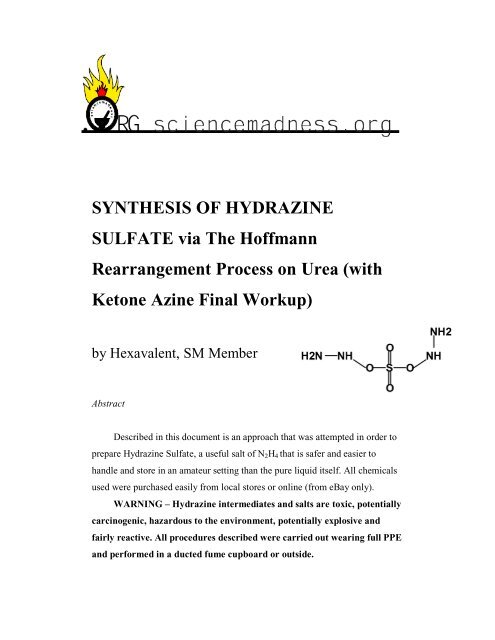SYNTHESIS OF HYDRAZINE SULFATE via The Hoffmann ...
SYNTHESIS OF HYDRAZINE SULFATE via The Hoffmann ...
SYNTHESIS OF HYDRAZINE SULFATE via The Hoffmann ...
You also want an ePaper? Increase the reach of your titles
YUMPU automatically turns print PDFs into web optimized ePapers that Google loves.
<strong>SYNTHESIS</strong> <strong>OF</strong> <strong>HYDRAZINE</strong><strong>SULFATE</strong> <strong>via</strong> <strong>The</strong> <strong>Hoffmann</strong>Rearrangement Process on Urea (withKetone Azine Final Workup)by Hexavalent, SM MemberAbstractDescribed in this document is an approach that was attempted in order toprepare Hydrazine Sulfate, a useful salt of N 2 H 4 that is safer and easier tohandle and store in an amateur setting than the pure liquid itself. All chemicalsused were purchased easily from local stores or online (from eBay only).WARNING – Hydrazine intermediates and salts are toxic, potentiallycarcinogenic, hazardous to the environment, potentially explosive andfairly reactive. All procedures described were carried out wearing full PPEand performed in a ducted fume cupboard or outside.
Introduction<strong>The</strong> <strong>Hoffmann</strong> Rearrangement Process on Urea was attempted and wascompleted with a 42% yield as a glistening, free-flowing white crystallinepowder. Simply, urea reacts with the hypochlorite ion in basic aqueous solutionto generate an aminoisocyanate intermediate which is then hydrolysed togenerate hydrazine and Na 2 CO 3 . A ketone (MEK) is then added to form methylethyl ketazine (aka butanone azine) which is separated off and treated withsulfuric acid to precipitate Hydrazine Sulfate and free excess MEK.
Experimental314g of 12.5% Sodium Hypochlorite (NaClO) solution was added to anErlenmeyer flask and was chilled in an ice bath atop a magnetic stirrer. Astir bar was added and medium-speed stirring was begun.53g (1.33 moles) of granular Sodium Hydroxide (NaOH) was slowlyadded in small portions. An exotherm is generated when this materialdissolves, and NaClO degrades rapidly at increased temperatures so the icebath is needed.39g (0.65 moles) of recrystallized urea was then added to a 1L singleneckRBF with 600mg (0.6g) of gelatine alongside 50ml of distilled water.After the addition of some boiling stones, the mixture was slowly heated inthe microwave on a low setting to help the solutes dissolve.A setup was prepared as followed; a hotplate/magnetic stirrer, on top of itthe RBF containing the urea/gelatine solution, with a claisen adapterattached; one neck connected to a pressure-equalizing dripping funnel andthe other neck to a cooled reflux condenser. <strong>The</strong> basic hypochlorite solutionwas added to the dripping funnel and was allowed to fall into the flask at arate of 1 drop/sec. Stirring was used continuously with the magnetic stirrer.NO heat was applied during this stage. <strong>The</strong> mixture turned to ayellow/brown colour at this stage.After the basic hypochlorite solution was added, the mixture was slowlyheated to 90*C whilst maintaining reflux. <strong>The</strong> yellow/brown colour slowlydissipated and when it goes clear the reaction has finished; the flask waspulled off the heat and allowed to cool to below 40*C.77g of 99.9% (1.07 moles) of MEK was then simply poured through thecondenser (the condenser was not removed from the flask to preventleakage of hydrazine vapours) and the mixture was stirred vigorously for 3hours for the layers to mix and form the azine.After stirring, the mixture was transferred to a separating funnel and thetwo layers of butanone azine/excess MEK and water/other contaminants
were allowed to separate. Clean separation was observed as the aqueouslayer was nearly saturated with NaCl, formed by the earlier reaction.<strong>The</strong> organic phase was removed and transferred to a clean RBF flask.<strong>The</strong>n, in a separate vessel, 40ml of 18M (~98%) sulfuric acid was slowlyadded to 100ml of water with stirring. <strong>The</strong> two mixtures were combinedwith stirring in the RBF.Some hydrazine sulfate crystallized out, but, the RBF was then set up forazeotropic distillation to remove any excess MEK and drive theprecipitation reaction to completion. <strong>The</strong> fraction boiling at 77.3*C wastaken (this was the MEK/H 2 O azeotrope) and was recycled for anotherbatch of this synthesis.Post-distillation, the flask was cooled in an ice bath to obtain as muchN 2 H 4 – H 2 SO 4 as possible. <strong>The</strong>n, it was vacuum filtered and air was pulledover the captured solid for 30 minutes to dry it on the frit.<strong>The</strong> solid was then transferred into an amber glass storage vessel labeledappropriately. Again, a 42% yield based on hypochlorite was obtained,which equates to 29.229g or 0.225 moles of N 2 H 4 • H 2 SO 4 .Experimenter’s NotesWhen adding the basic NaOCl sol’n to the urea/gelatine mixture, a largeamount of foam was generated which subsided with powerful stirring and time.Sources and References http://www.youtube.com/watch?v=UB7vwIFCnR0 (NurdRage’s video) http://www.youtube.com/watch?v=JCrDttuw5co (UnintentionalChaos’video) http://www.sciencelab.com/msds.php?msdsId=9927191 (MSDS forHydrazine Sulfate, by ScienceLab) http://en.wikipedia.org/wiki/Hydrazine_sulfate (Wikipedia Article)
















